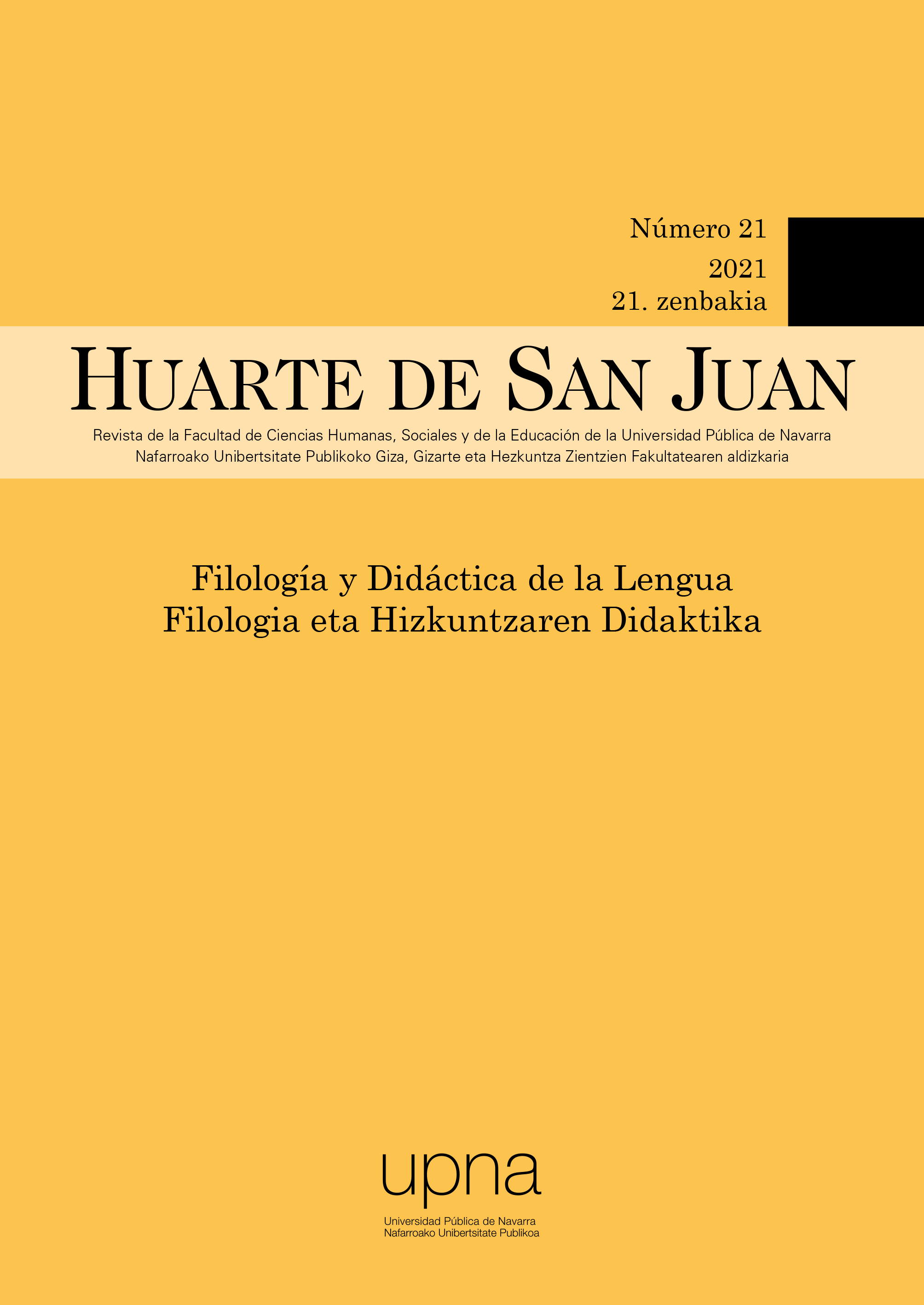Interactive Atlas of Basque Prosody
DOI:
https://doi.org/10.48035/rhsj-fd.21.10Keywords:
Atlasa; prosodia; euskara, interaktiboa, intonazioa; azentuaAbstract
The main objective of this work is to present the Interactive Atlas of Basque Prosody / Euskararen Atlas Prosodiko Interaktiboa (EAPI). EAPI is the first multimedia and interactive tool for prosody in Basque. This atlas has a database made up mainly of the EDAK and EAS corpora created by the EUDIA research group of the UPV/EHU. The atlas shows the analyses carried out on prosody: the location of the accent in all the varieties and syllables of Basque; the most significant intonation patterns of basic sentences, both in standard Basque and in dialects; and opens the way for the prosodic analysis of spontaneous and read texts. With this atlas Basque is placed on an international level on a par with other languages developed in the field of prosody.
Downloads
References
Allières, J. (1978). Petit Atlas linguistique basque français ‘Bourciez I’ (20 cartes commentées). Fontes Linguae Vasconum, 27, 353-386.
Allières, J. (1986). Petit atlas linguistique basque français ‘Bourciez II’ (30 cartes commentées). Fontes Linguae Vasconum, 47, 5-45.
Aranzadi Zientzia Elkartea. (1983). Euskal Herriko Atlas Etnolinguistikoa 1. Donostia: Aranzadi Zientzia Elkartea.
Aranzadi Zientzia Elkartea. (1990). Euskal Herriko Atlas Etnolinguistikoa 2. Donostia: Aranzadi Zientzia Elkartea.
Aurrekoetxea, G., Gaminde, I., Iglesias, A. & Gandarias, L. (2013). Prosodic Variation in the Basque Language: Stress Areas. En E. Carrilho, C. Magro & X. Álvarez (Eds.), Current Approaches to Limits and Areas in Dialectology. (247-266). Newcastle: Cambridge Scholars Publishing.
Aurrekoetxea, G., Videgain, X., & Iglesias, A. (2004). ‘Bourciez’ bildumako Euskal Atlasa: 1. Lexikoa. ASJU XXXVIII-2.
Aurrekoetxea, G., Videgain, X., & Iglesias, A. (2005). ‘Bourciez’ bildumako Euskal Atlasa: 2. Gramatika. ASJU XXXIX-1.
Bonaparte, L. L. (1863). Carte des sept Provinces Basques. London: Stanford’s Geographical Establishment.
Bourciez, E. (1895). Recueil des idiomes de la région gasconne. (Eskuizkribua). Bordeaux: Bibliothèque Universitaire des Lettres.
Elordieta, G. & Hualde, J.I. (2014). Intonation in Basque. The phonology of intonation and phrasing, 405-463.
Etchebest, X. (2017). Zuberotar dardarkarien bariazio sozio-fonetikoa. (Doktoretza tesia. UPPA & UPV/EHU).
Etxaide, A.M. (1984). Erizkizundi hirukoitza / Triple cuestionario / Triple questionnaire (Euskera 1925). IKER 3. Bilbo: Euskaltzaindia.
Etxebarria, A. & Eguskiza, N. (Eds.) (2018). Bariazioa esaldien intonazioan. Bilbao: UPV/EHU.
Etxebarria, A., Eguskiza, N., Gaminde, I., & Romero, A. (2018). Ahots seduzitzaileen ezaugarriak generoaren ikuspegitik. En L. Unamuno, A. Romero, A. Etxebarria & A. Iglesias (Eds.), Linguistic variation in the Basque language and Education/Euskararen bariazioa eta bariazioaren irakaskuntza (43-59). Leioa: UPV/EHU.
Etxebarria, A., Gaminde, I., Romero, A. & Iglesias, A. (2016). Desarrollo de la competencia prosódica en la lectura en voz alta: importancia de las pausas. OCNOS Revista de estudios sobre lectura, 15, 110-118.
Etxebarria, A., Sanz, A., Garay, U. & Romero, A. (2017). Unibertsitateko ikasle elebidunen prosodia gaitasuna Txanogorritxu ipuinaren kontaketan: muga-tonuak. En A. Iglesias & A. Ensunza (Eds.), Gotzon Aurrekoetxea lagunarterik hara (111-122) Bilbao: UPV/EHU.
Etxebarria, J. M. (2016). Gorbeia inguruko etnoipuin eta esaundak II. Bilbo: Deustuko Unibertsitatea & Euskaltzaindia. Euskaltzaindia (2008-2019). Euskararen Herri Hizkeren Atlasa (10 liburuki). Bilbo: Euskaltzaindia.
Gaminde, I. (1985e). Aditza Ipar Goi Nafarreraz III. Iruña: UEU. Gaminde, I. (1994). Bilboko Larraskituko euskaraz: Lexikoa eta Testuak. Bilbo: Bilboko Udala.
Gaminde, I. (1985a). Aditza Bizkaieraz II. Iruña: UEU.
Gaminde, I. (1985b). Aditza Bizkaieraz III. Iruña: UEU.
Gaminde, I. (1985c). Aditza Ipar Goi Nafarreraz I. Iruña: UEU.
Gaminde, I. (1985d). Aditza Ipar Goi Nafarreraz II. Iruña: UEU.
Gaminde, I., Aurrekoetxea, G., Etxebarria, A., Garay, U., & Romero, A. (2014). Ahoskera lantzeko argibideak eta jarduerak. Laguntzarako materiala: teoria eta praktika. Leioa: UPV/EHU.
Gaminde, I., Etxebarria, A., Romero, A., & Eguskiza, N. (2017a). Características de la competencia prosódica de jóvenes bilingües vascos en la lectura en voz alta: las cumbres tonales. Revista de Lingüística Teórica y Aplicada, 55, 35-72.
Gaminde, I., Iglesias, A., Eguskiza, N., & Etxebarria, A. (2017b). Tasun akustikoen eragina jarreren bereizkuntzan. Ikastorratza, 19, 126-149.
Martínez Celdrán, E. , & Fernández Planas, A. M. (Coords.). (2003-2018). Atlas Multimèdia de la Prosòdia de l’Espai Romànic. http://stel.ub.edu/labfon/amper/cast/index_ampercat.html [24-02-2020]
Martínez Celdrán, E., & Fernández Planas, A. M. (2005). Estudio metodológico acerca de la obtención del corpus fijo en el proyecto AMPER. Estudios de fonética experimental, 14, 29-66.
Prieto, P., & Cabré, T. (Coords.). (2007-2012). Atles interactiu de l’entonació del català. http://prosodia.upf.edu/atlesentonacio [10-02-2020]

Downloads
Published
How to Cite
Issue
Section
License
Copyright (c) 2022 Aitor Iglesias

This work is licensed under a Creative Commons Attribution-NonCommercial-NoDerivatives 4.0 International License.
All articles are published under a Creative Commons (BY-NC-ND 4.0) license. Each article will be assigned a DOI.
Authors retain copyright of their work and grant the journal the right to the first publication. Authors can sign additional agreements to non-exclusive distribution of the published version of the article (for example, in an institutional repository) as long as appropriate attribution to the original publication is provided. Articles can be uploaded to institutional repositories immediately after publication.
Electronic distribution of the articles (for example, academic social networks or personal webpages) is allowed and encouraged.
The journal reserves the right to publicise the work in social networks and other electronic means.






